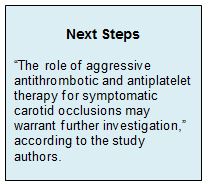Key Points:
- Study examines microembolic signals on imaging in patients with symptomatic carotid occlusion or stenosis
- Evidence of microembolism more common than expected, even in patients with watershed pattern of infarction

Ava L. Liberman, MD, of Albert Einstein College of Medicine (New York NY), and colleagues conducted a prospective observational cohort study of patients hospitalized within 7 days of ischemic stroke or transient ischemic attack because of ≥ 50% carotid artery stenosis or occlusion.
At 90 days’ follow-up, 47 patients (28 with carotid stenosis and 19 with carotid occlusion) had undergone transcranial Doppler emboli detection of the middle cerebral artery ipsilateral to the symptomatic carotid to identify the presence of microembolic signals and characterize infarct topography.
Overall, microembolic signals were detected in 18 patients. There was no difference in the prevalence of these signals between patients with carotid occlusions versus stenosis (37% vs 39%; P = .87). Among the 39 patients radiographic evidence of infarction, 15 (38%) had a watershed pattern, 16 (41%) had a nonwatershed pattern, and 8 (21%) had a combination. Microembolic signals were present in 6 (40%) of the patients with a watershed pattern of infarction.
Recurrent cerebral ischemia occurred in 9 patients (19%): 6 had transient ischemic attack and 3 had ischemic stroke. There was no difference in the rate of recurrence in those with and without microembolic signals.
Surprising New Findings Raise Questions
“Our finding of frequent microembolization in patients with a watershed pattern of infarction on imaging has not been previously reported in patients with extracranial carotid disease,” Dr. Liberman told NVX in an email. “Though watershed infarctions are frequently thought to be due to cerebral hypoperfusion, our findings suggest that embolization may play an important mechanistic role in symptomatic ischemia.”
In an email to NVX, Perry Ng, MD, of Centura Health Physician Group (Denver, CO), explained that “the concept of stump emboli originating from the proximal internal carotid artery (ICA) stump into external carotid branches and then intracranially through external-to-internal carotid artery anastomoses or from stagnant blood in the segment of ICA that remains patent above an occlusion has traditionally been used to explain the occurrence of emboli strokes in patients with carotid occlusion.” But the study, he said, demonstrates that the phenomenon of stump emboli occurs about as commonly in patients with carotid stenosis as in those with carotid occlusions.
Dr. Ng pointed out, however, that the study has important limitations. These include a small cohort, use of CT scans to detect stroke and embolic vs watershed etiology when MRI is the gold standard, and lack of detailed information as to the type of vascular imaging studies used to detect carotid stenosis ≥ 50% severity or carotid occlusion.
“Carotid duplex is operator-dependent and may under- or overestimate the degree of stenosis or call an occlusion when there is very slow flow,” he said. “CT angiography can similarly overcall carotid occlusion in the event of trickle flow through a very stenotic and chronically low-flow ICA. Heavy calcification of carotid plaque can also hinder accurate assessment of the degree of carotid stenosis. DSA is the gold standard but it is usually reserved for troubleshooting disparate carotid duplex and CTA findings nowadays.”
Dr. Liberman acknowledged some of these limitations, noting, “Our work is limited by the absence of cerebral flow data.”
Both investigators agreed that the logical next step is a prospective trial to investigate the use of early anticoagulation and other aggressive medical therapies for patients with carotid disease who are waiting for definitive revascularization procedures.
“We need a larger cohort and more robust methods to determine the degree of carotid stenosis vs occlusion and the etiology of infarctions on cross-sectional imaging,” said Dr. Ng. “We also need to randomize subgroups into treatment regimens such as single vs dual antiplatelets vs anticoagulation and correlate with clinical outcome (ie, recurrent stroke).”
Source:
Liberman AL, Zandieh A, Loomis C, et al. Symptomatic carotid occlusion is frequently associated with microembolization. Stroke. 2017;Epub ahead of print.
Disclosures:
Drs. Liberman and Ng report no relevant conflicts of interest.

